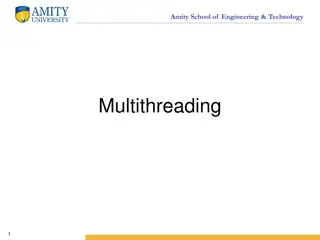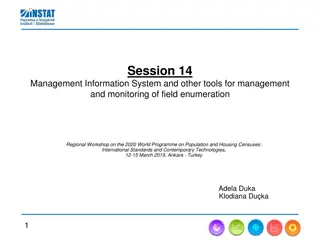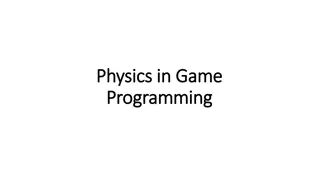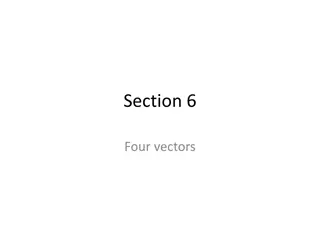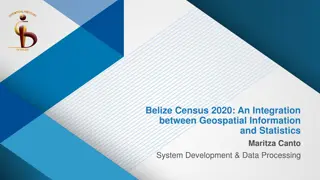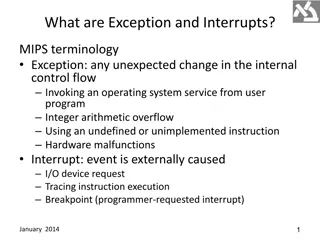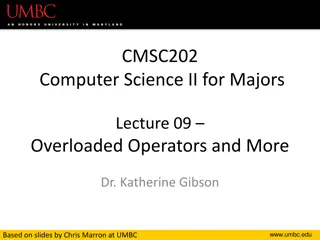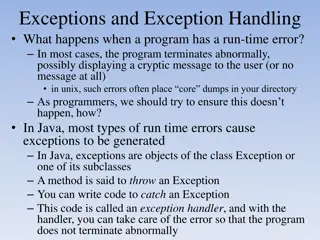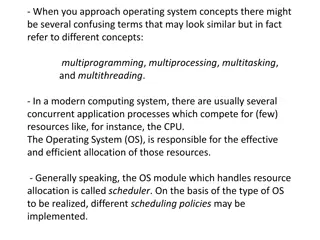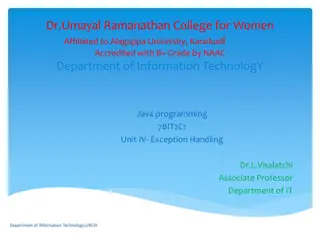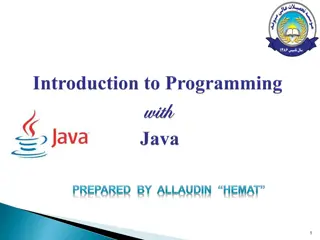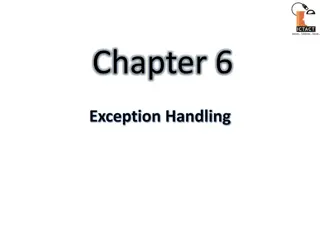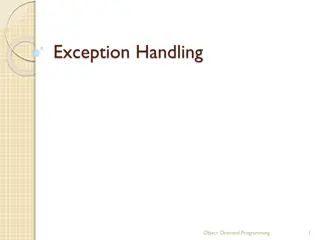
Core Java Multithreading and Exception Handling Overview
Discover the fundamentals of core Java multithreading, vectors, enumeration, and exception handling through insightful explanations and sample code snippets. Learn about creating threads, running parallel programs, multithreading lifecycle, and thread priorities. Enhance your understanding of multithreading concepts with Sudha Bhagavatheeswaran from SIES College of Arts, Science & Commerce.
Uploaded on | 2 Views
Download Presentation

Please find below an Image/Link to download the presentation.
The content on the website is provided AS IS for your information and personal use only. It may not be sold, licensed, or shared on other websites without obtaining consent from the author. If you encounter any issues during the download, it is possible that the publisher has removed the file from their server.
You are allowed to download the files provided on this website for personal or commercial use, subject to the condition that they are used lawfully. All files are the property of their respective owners.
The content on the website is provided AS IS for your information and personal use only. It may not be sold, licensed, or shared on other websites without obtaining consent from the author.
E N D
Presentation Transcript
CORE JAVA Multithreading, Vectors, Enumeration, Exception Handling Sudha Bhagavatheeswaran, Department of Information Technology, SIES College of Arts, Science & Commerce (Autonomous)
MULTITHREADING Thread a program that has a single flow of control (one task) Multithreading sub-parts of a program implemented in parallel Creating a thread Thread class and Runnable interface Thread class and Runnable Interface in java.lang package main thread Thread C Thread A Thread B Sudha Bhagavatheeswaran, Department of Information Technology, SIES College of Arts, Science & Commerce (Autonomous)
MULTITHREADING LIFE CYCLE Sudha Bhagavatheeswaran, Department of Information Technology, SIES College of Arts, Science & Commerce (Autonomous)
MULTITHREADING CREATING THREADS USING THREAD CLASS class A extends Thread { public void run( ) { for(int i = 1; i <= 5; i++) { System.out.println("Thread A with i = +i); } System.out.println("Exit from Thread A ..."); } } class C extends Thread { public void run( ) { for(int k = 1; k <= 5; k++) { System.out.println("Thread C with k = +k); } System.out.println("Exit from Thread C "); } } class B extends Thread { public void run( ) { for(int j = 1; j <= 5; j++) { System.out.println("Thread B with j = +j); } System.out.println("Exit from Thread B "); } } public class Demo { public static void main(String args[]) { A a = new A(); B b = new B(); C c = new C(); a.start(); b.start(); c.start(); } } Sudha Bhagavatheeswaran, Department of Information Technology, SIES College of Arts, Science & Commerce (Autonomous)
MULTITHREADING CREATING THREADS USING RUNNABLE INTERFACE class C implements Runnable { public void run( ) { for(int k = 1; k <= 5; k++) { System.out.println("Thread C with k = +k); } System.out.println("Exit from Thread C "); } } class A implements Runnable { public void run( ) { for(int i = 1; i <= 5; i++) { System.out.println("Thread A with i = +i); } System.out.println("Exit from Thread A ..."); } } public class Demo { public static void main(String args[]) { A a = new A(); Thread t1 = new Thread(a); B b = new B(); Thread t2 = new Thread(b); C c = new C(); Thread t3 = new Thread(c); t1.start(); t2.start(); t3.start(); } } class B implements Runnable { public void run( ) { for(int j = 1; j <= 5; j++) { System.out.println("Thread B with j = +j); } System.out.println("Exit from Thread B "); } } Sudha Bhagavatheeswaran, Department of Information Technology, SIES College of Arts, Science & Commerce (Autonomous)
MULTITHREADING THREAD PRIORITIES Priority of a thread tells how early it gets execution and is selected by the thread scheduler. In Java, when we create a thread, always a priority is assigned to it. In a Multithreading environment, the processor assigns a priority to a thread scheduler. The priority is given by the JVM or by the programmer itself explicitly. The range of the priority is between 1 to 10. There are three constant variables which are static and used to fetch priority of a Thread. They are:- 1. public static int MIN_PRIORITY It holds the minimum priority that can be given to a thread. The value for this is 1. 2. public static int NORM_PRIORITY It is the default priority that is given to a thread if it is not defined. The value for this is 5. 3. public static int MAX_PRIORITY It is the maximum priority that can be given to a thread. The value for this is 10. Sudha Bhagavatheeswaran, Department of Information Technology, SIES College of Arts, Science & Commerce (Autonomous)
MULTITHREADING Get and Set methods in Thread priority 1. public final int getPriority() getPriority() method is in java.lang.Thread package. it is used to get the priority of a thread. 2. public final void setPriority(int newPriority) setPriority(int newPriority) method is in java.lang.Thread package. It is used to set the priority of a thread. setPriority(int priority) 1 10 5 Thread.MAX_PRIORITY Thread.MIN_PRIORITY Thread.NORM_PRIORITY Sudha Bhagavatheeswaran, Department of Information Technology, SIES College of Arts, Science & Commerce (Autonomous)
MULTITHREADING CREATING THREADS WITH PRIORITY class C extends Thread { public void run( ) { for(int k = 1; k <= 5; k++) { System.out.println("Thread C with k = +k); } System.out.println("Exit from Thread C "); } } class A extends Thread { public void run( ) { for(int i = 1; i <= 5; i++) { System.out.println("Thread A with i = +i); } System.out.println("Exit from Thread A ..."); } } public class Demo { public static void main(String args[]) { A t1 = new A(); B t2 = new B(); C t3 = new C(); t3.setPriority(Thread.MAX_PRIORITY); t2.setPriority(t3.getPriority() - 1); t1.setPriority(Thread.MIN_PRIORITY); t1.start(); t2.start(); t3.start(); } } class B extends Thread { public void run( ) { for(int j = 1; j <= 5; j++) { System.out.println("Thread B with j = +j); } System.out.println("Exit from Thread B "); } } Sudha Bhagavatheeswaran, Department of Information Technology, SIES College of Arts, Science & Commerce (Autonomous)
MULTITHREADING Thread class (java.lang) CONSTRUCTORS public Thread() Allocates a new Thread object. Thread t = new Thread(); public Thread(Runnable r) Allocates a new Thread object for a runnable type A ob = new A(); //A is of type Runnable since class A implements Runnable Thread t = new Thread(ob); public Thread(String name) Allocates a new Thread object with the given name Thread t = new Thread( SIES ); public Thread(Runnable r, String name) Allocates a new Thread object for r with the given name A ob = new A(); //A is of type Runnable since class A implements Runnable Thread t = new Thread(ob, SIES ); Sudha Bhagavatheeswaran, Department of Information Technology, SIES College of Arts, Science & Commerce (Autonomous) Sudha . B SIES College of Arts, Science & Commerce (Autonomous)
MULTITHREADING Thread class (java.lang) METHODS public final String getName() - Returns this thread's name. String s= t.getName(); public final void setName(String name) - Changes the name of this thread to the given name t.setName( ABC ); public final int getPriority() - Returns this thread's priority. int i = t.getPriority(); public final void setPriority(int newPriority) - Changes the priority of this thread. t.setPriority(Thread.MAX_PRIORITY); public void start() - Causes this thread to begin execution; the Java Virtual Machine calls the run method of this thread. t.start(); public void run() - This method has to be overridden by the class that extends Thread. There is no statement for run() since run() is automatically called when start() is called public static void sleep(long millis) throws InterruptedException - Causes the currently executing thread to sleep (temporarily cease execution) for the specified number of milliseconds. Thread.sleep(3000);
MULTITHREADING Runnable interface(java.lang) METHODS void run() This abstract method has to be overridden by the class that implements Runnable There is no statement for run() since run() is automatically called when start() is called Sudha Bhagavatheeswaran, Department of Information Technology, SIES College of Arts, Science & Commerce (Autonomous) Sudha . B SIES College of Arts, Science & Commerce (Autonomous)
VECTORS ARRAYS VECTORS Datatype , Arrays class belongs to java.util package java.util package Static; does not expand automatically Dynamic; expands automatically Contains variables of primitive data types and objects Contains variables of primitive data types Zero based index Zero based index Sudha Bhagavatheeswaran, Department of Information Technology, SIES College of Arts, Science & Commerce (Autonomous)
VECTORS Creating a vector Adding element to a vector Accessing elements Removing elements Searching for elements Retreiving/setting vector size Sudha Bhagavatheeswaran, Department of Information Technology, SIES College of Arts, Science & Commerce (Autonomous)
VECTORS CREATING A VECTOR public Vector() Constructs an empty vector Vector v = new Vector(); public Vector(Element e) Constructs a vector containing the element (of any data type) Vector v = new Vector(10); Sudha Bhagavatheeswaran, Department of Information Technology, SIES College of Arts, Science & Commerce (Autonomous) Sudha . B SIES College of Arts, Science & Commerce (Autonomous)
VECTORS ADDING ELEMENTS TO A VECTOR public boolean add(E e) Appends the specified element to the end of this Vector. Vector v = new Vector(); v.add( SIES ); public void add(int index,E element) Inserts the specified element at the specified position in this Vector. Shifts the element currently at that position (if any) and any subsequent elements to the right (adds one to their indices). v.add(2, SIES ); Sudha Bhagavatheeswaran, Department of Information Technology, SIES College of Arts, Science & Commerce (Autonomous) Sudha . B SIES College of Arts, Science & Commerce (Autonomous)
VECTORS ACCESSING ELEMENTS IN A VECTOR public E elementAt(int index) Returns the component at the specified index. E e = v.elementAt(3); public E firstElement() Returns the first component (the item at index 0) of this vector. E e = v.firstElement(); public E lastElement() Returns the last component of the vector. E e =v.lastElement(); Sudha Bhagavatheeswaran, Department of Information Technology, SIES College of Arts, Science & Commerce (Autonomous) Sudha . B SIES College of Arts, Science & Commerce (Autonomous)
VECTORS REMOVING ELEMENTS IN A VECTOR public void removeElementAt(int index) Deletes the component at the specified index and shifts the other elements accordingly. v.removeElementAt(6); public boolean removeElement(Object obj) Removes the first (lowest-indexed) occurrence of the argument from this vector. v.removeElement(45); public void removeAllElements() Removes all components from this vector and sets its size to zero. v. removeAllElements(); Sudha Bhagavatheeswaran, Department of Information Technology, SIES College of Arts, Science & Commerce (Autonomous) Sudha . B SIES College of Arts, Science & Commerce (Autonomous)
VECTORS SEARCHING FOR AN ELEMENT IN A VECTOR public boolean contains(Object o) Returns true if this vector contains the specified element. boolean b = v.contains(67); Sudha Bhagavatheeswaran, Department of Information Technology, SIES College of Arts, Science & Commerce (Autonomous) Sudha . B SIES College of Arts, Science & Commerce (Autonomous)
VECTORS RETREIVING/SETTING VECTOR SIZE public int size() Returns the number of components in this vector. int y = v.size(); public void setSize(int newSize) Sets the size of this vector. v.setSize(10); Sudha Bhagavatheeswaran, Department of Information Technology, SIES College of Arts, Science & Commerce (Autonomous) Sudha . B SIES College of Arts, Science & Commerce (Autonomous)
VECTORS The elements of vector: [10,20,30, Sharanam Shah] The size of the vector are: 4 The element at position 2 is : 30 The first element of the vector is : 10 The last element of the vector is : Sharanam Shah The elements of the vector: [10,20,Sharanam Shah] The elements are: 10 The elements are: 20 The elements are: Sharanam Shah Sudha Bhagavatheeswaran, Department of Information Technology, SIES College of Arts, Science & Commerce (Autonomous)
ENUMERATION - ENUMS Enumerations serve the purpose of representing a group of named constants in a programming language. Enums are used when we know all possible values at compile time public enum Suit { CLUB,DIAMOND,HEARTS,SPADE} public enum Day { SUNDAY, MONDAY, TUESDAY, WEDNESDAY, THURSDAY, FRIDAY, SATURDAY } public enum graduate {YES,NO} public enum graduate { MATHS, STATISTICS,CHEMISTRY, COMMERCE, IT, CS} Sudha Bhagavatheeswaran, Department of Information Technology, SIES College of Arts, Science & Commerce (Autonomous)
ENUMERATION - ENUMS package etest; public enum Book {ORACLE,JAVAEE,JSP} package etest; public class EnumTest { public static void main(String args[]) { Book [ ] bk=Book.values(); for (Book b:bk) { System.out.println ( b.ordinal() + The royalty of book + b.toString() + is + BookRoyalty.calculateRoyalty(b)); } } } package etest; public class BookRoyalty { public static double calculateRoyalty(Book b) { double royalty=0.0; if(b.equals(Book.ORACLE)) {royalty=50000;} else if(b.equals(Book.JAVAEE)) {royalty=100000;} else if(b.equals(Book.JSP)) {royalty=250000;} return royalty; } } OUTPUT:- 1. The royalty of book ORACLE is 50000 2. The royalty of book JAVAEE is 100000 3. The royalty of book JSP is 250000 Sudha Bhagavatheeswaran, Department of Information Technology, SIES College of Arts, Science & Commerce (Autonomous)
EXCEPTION HANDLING Exceptions :- run time errors occurring in the program. In java, Exception is an object Exception object is an object that describes an exceptional condition that has occurred in a piece of code try catch throw throws finally Sudha Bhagavatheeswaran, Department of Information Technology, SIES College of Arts, Science & Commerce (Autonomous)
EXCEPTION HANDLING JAVA EXCEPTION KEYWORDS try The "try" keyword is used to specify a block where we should place an exception code. It means we can't use try block alone. The try block must be followed by either catch or finally. catch The "catch" block is used to handle the exception. It must be preceded by try block which means we can't use catch block alone. It can be followed by finally block later. finally The "finally" block is used to execute the necessary code of the program. It is executed whether an exception is handled or not. throw The "throw" keyword is used to throw an exception. throws The "throws" keyword is used to declare exceptions. It specifies that there may occur an exception in the method. It doesn't throw an exception. It is always used with method signature. Sudha . B SIES College of Arts, Science & Commerce (Autonomous)
EXCEPTION HANDLING class A {public static void main(String args[]) { int d=0; int a=42/d; System.out.println( d= +d); } } class A {public static void main(String args[]) { int d,a; try { d=0; a=42/d; System.out.println( d= +d); } catch (ArithmeticException e) {System.out.println( Division by zero ); } System.out.println( After catch statement ); } } OUTPUT:- Exception in thread "main" java.lang.ArithmeticException: / by zero at A.main(A.java:4) OUTPUT:- Division by zero After catch statement Sudha Bhagavatheeswaran, Department of Information Technology, SIES College of Arts, Science & Commerce (Autonomous)
EXCEPTION HANDLING Displaying description of the exception (Throwable overrides toString() method of class Object) class A {public static void main(String args[]) { int d,a; try { d=0; a=42/d; System.out.println( d= +d); } catch (Exception e) {System.out.println( error is +e); } System.out.println( After catch statement ); } } OUTPUT:- error is java.lang.ArithmeticException: / by zero After catch statement Sudha Bhagavatheeswaran, Department of Information Technology, SIES College of Arts, Science & Commerce (Autonomous)
EXCEPTION HANDLING Multiple catch statements OUTPUT:- (if args is zero) class A {public static void main(String args[]) { try { int a=args.length; System.out.println("a="+a); int b=42/a; int c[]={1}; c[20]=100; } catch (ArithmeticException e) {System.out.println("error is " + e); } catch (ArrayIndexOutOfBoundsException e) {System.out.println("array out of range"); } System.out.println("After catch statement"); } } D:\>java A a=0 error is java.lang.ArithmeticException: / by zero After catch statement OUTPUT:- (if args is not zero) D:\>java A 10 20 30 a=3 array out of range After catch statement Sudha Bhagavatheeswaran, Department of Information Technology, SIES College of Arts, Science & Commerce (Autonomous)
EXCEPTION HANDLING public class Test { static void validate(int age) { if (age<18) throw new ArithmeticException( not valid ); else System.out.println( WELCOME TO VOTE ); } public static void main(String args[]) { validate(10); System.out.println( VALIDATED ); } } } public class Test { static void validate(int age) { if (age<18) throw new ArithmeticException( not valid ); else System.out.println( WELCOME TO VOTE ); } public static void main(String args[]) { validate(30); System.out.println( VALIDATED ); } throw (statement) throw Throwable instance; 1. Must be an object of Throwable or subclass of Throwable 2. Must not be primitive types, non-Throwable object OUTPUT:- OUTPUT:- WELCOME TO VOTE VALIDATED Exception in thread "main" java.lang.ArithmeticException: not valid at Test.validate(Test.java:4) at Test.main(Test.java:9) Sudha Bhagavatheeswaran, Department of Information Technology, SIES College of Arts, Science & Commerce (Autonomous)
EXCEPTION HANDLING throws (keyword) class A { void abc() throws ArithmeticException , ArrayIndexOutOfBoundsException { int a=0; System.out.println("a="+a); int b=42/a; int c[]={1}; c[20]=100; } } } class A { void abc() throws ArithmeticException , ArrayIndexOutOfBoundsException { int a=2; System.out.println("a="+a); int b=42/a; int c[]={1}; c[20]=100; 1. Must be included in a method s declaration 2. Must list the exceptions that a method might throw class Test {public static void main(String args[]) { try { A ob=new A(); ob.abc(); } catch (ArithmeticException e) {System.out.println( Divide by zero ); } catch (ArrayIndexOutOfBoundsException e) {System.out.println("array out of range"); } System.out.println("After catch statement"); } } OUTPUT:- OUTPUT:- D:\>java Test a=0 Divide by zero After catch statement After catch statement D:\>java Test a=2 array out of range Sudha Bhagavatheeswaran, Department of Information Technology, SIES College of Arts, Science & Commerce (Autonomous)
EXCEPTION HANDLING public class Test { static void validate(int age) throws MyException { if (age<18) throw new MyException( not valid ); else System.out.println( WELCOME TO VOTE ); } public static void main(String args[]) { try { validate(40); } catch(Exception e) { System.out.println( error occurred ); } System.out.println( After catch statement ); USER DEFINED EXCEPTIONS public class Test { static void validate(int age) throws MyException { if (age<18) throw new MyException( not valid ); else System.out.println( WELCOME TO VOTE ); } public static void main(String args[]) { try { validate(10); } catch(Exception e) { System.out.println( error occurred ); } System.out.println( After catch statement ); } } 1. Create a subclass of Exception class 2. Two kinds of constructors may be used For eg:- MyException() OR MyException(String str) { super(str); } 3. To raise the exception, we need to create an object of the user defined exception class and throw its object class MyException extends Exception { MyException(String s) { super(s); } } OUTPUT:- OUTPUT:- D:\>java Test WELCOME TO VOTE D:\>java Test error occurred After catch statement After catch statement Sudha Bhagavatheeswaran, Department of Information Technology, SIES College of Arts, Science & Commerce (Autonomous)




